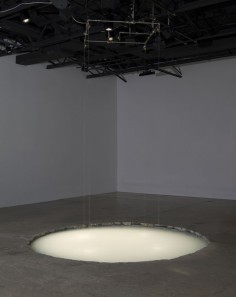DOUG AITKEN
ダグエイケン
道格·艾特肯
sonic fountain

source: galleristny
A large round hole—if it were a hot tub, it would be comfortably orgy-sized—has been gouged roughly out of the slick concrete floor of 303 Gallery and filled with milky gray water. Attached to the black duct-work and girders of the ceiling directly above it is a square of pipe surrounded by a speaker array. In the center of the square and at each of its corners is a computer-controlled spigot, dripping, spitting or jetting out, in a rhythmically complex 15-minute cycle, milky water pumped up from the pit in a closed circuit. This is Doug Aitken’s Sonic Fountain. Sometimes the surface is choppy, but sometimes the shadowy, intersecting circles are subtle enough to pass for an optical illusion. If the water, evaporation excepted, moves in a closed circuit of spectacle and bravado, the sonic circuit is discontinuous: the speakers are hooked to submerged microphones and play a kind of live underwater gamelan over the less resonantly percussive noise of the drips against the surface. But while you know it’s live—because you hear the speakers from above while looking down, and because the sound is so watery but you can feel that you’re standing in dry air—it sounds like a replay.
.
.
.
.
.
.
.
source: dougaitkenworkshop
Doug Aitken was born in California in 1968. He lives and works in Los Angeles and New York. Widely known for his innovative fine art installations, Doug Aitken is at the forefront of 21st century communication. Utilizing a wide array of media and artistic approaches, his eye leads us into a world where time, space, and memory are fluid concepts.
Aitken’s body of work ranges from photography, sculpture, and architectural interventions, to films, sound, single and multi-channel video works, and installations. His work has been featured in numerous solo and group exhibitions around the world, in such institutions as the Whitney Museum of American Art, The Museum of Modern Art, the Vienna Secession, the Serpentine Gallery in London and the Centre Georges Pompidou in Paris. He participated in the Whitney Biennial 1997 and 2000 and earned the International Prize at the Venice Biennale in 1999 for the installation “electric earth”.
Aitken’s “Sleepwalkers” exhibition at MoMA in 2007 transformed an entire block of Manhattan into an expansive cinematic experience as he covered the museum’s exteriors walls with projections. In 2009, his Sonic Pavilion opened to the public in the forested hills of Brazil at the new cultural foundation INHOTIM. Continuing his work in innovative outdoor projects, Aitken presented his large-scale film and architecture installation, “Frontier”, on Rome’s Isola Tiberina in November 2009 and at Art Basel Unlimited in 2010. Recently, Aitken’s multiform artwork “Black Mirror” engaged a site-specific multi-channel video installation and a live theatre performance on a uniquely designed barge floating off Athens and Hydra Island, Greece.
.
.
.
.
.
.
.
source: inhotim
Desde os anos 1990, Doug Aitken (Redondo Beach, EUA, 1968; vive em Los Angeles, EUA) desenvolve uma série de filmes, fotografias, instalações e vídeos que investigam a relação entre natureza, memória, tempo e espaço. Sua obra fala de lugares inabitados, ruínas, vestígios de onde o tempo parece ter outro ritmo. O artista tem concentrado boa parte de sua pesquisa recente a instalações com vídeos e a seus filmes, embora a preocupação com o espaço arquitetônico sempre esteja presente nos trabalhos.
Doug Aitken participou de diversas exposições individuais e coletivas, assim como tem exibido sua obra em festivais de cinema e de vídeo. Entre seus projetos recentes mais importantes, destacam-se Migration (2008), na mostra Carnegie International (Pittsburgh, EUA), e Sleepwalkers (2007), exibido na fachada do Museum of Modern Art, em Nova York. Em 2005, expôs no Musée d’Art Moderne de la Ville de Paris. Em 1999, recebeu o prêmio Leão de Ouro da Bienal de Veneza pela instalação “Electric Earth”.
.
.
.
.
.
.
.
source: inhotim
edondo Beach, Estados Unidos, 1968; vive en Los Ángeles, Estados Unidos. Desde los años 90, Doug Aitken (Redondo Beach, EUA, 1968; vive en Los Ángeles, EUA) desarrolla una serie de películas, fotografías, instalaciones y vídeos que investigan la relación entre naturaleza, memoria, tiempo y espacio. Su obra habla de lugares inhabitables, ruinas, vestigios donde el tiempo parece tener otro ritmo. El artista ha concentrado buena parte de su investigación reciente en las instalaciones con vídeos y en sus filmes, aunque la preocupación por el espacio arquitectónico siempre esté presente en los trabajos.
Doug Aitken participó de diversas exposiciones individuales y colectivas, así como también ha exhibido su obra en festivales de cine y de vídeo. Entre sus proyectos recientes más importantes se destacan Migration (2008), en la muestra Carnegie International (Pittsburgh, EUA), y Sleepwalkers (2007), exhibido en la fachada del Museum of Modern Art, en Nueva York. Em 2005, expuso en el Musée d’Art Moderne de la Ville de París. En 1999 recibió el premio Leão de Ouro de la Bienal de Venecia por la instalación “Electric Earth”.
.
.
.
.
.
.
.
source: artobserved
Working across a broad body of media and techniques, including photography, sculpture, video, installation, sound art and architectural interventions, Los Angeles-based artist Doug Aitken’s work frequently explores concepts of rhythm, repetition and duration, exploring interrelations between time, memory and space and the subsequent fluctuations of meaning and understanding caused by their interactions. His work has been ehxibited in a variety of institutions and contexts, including his enormous Song1 installation on the outside of the Hirshhorn Museum in Washington, DC, as well as his upcoming video art installation at the Seattle Art Museum.

